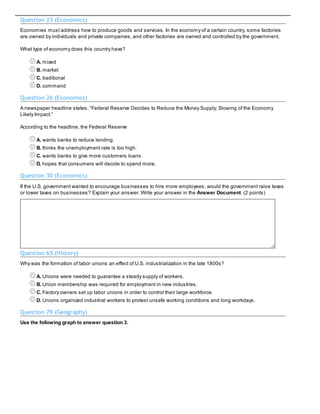
Economics & Mixed Economy Questions
- 1. Question 23 (Economics) Economies must address how to produce goods and services. In the economy of a certain country, some factories are owned by individuals and private companies, and other factories are owned and controlled by the government. What type of economy does this country have? A. mixed B. market C. traditional D. command Question 26 (Economics) A newspaper headline states, “Federal Reserve Decides to Reduce the Money Supply; Slowing of the Economy Likely Impact.” According to the headline, the Federal Reserve A. wants banks to reduce lending. B. thinks the unemployment rate is too high. C. wants banks to give more customers loans. D. hopes that consumers will decide to spend more. Question 30 (Economics) If the U.S. government wanted to encourage businesses to hire more employees, would the government raise taxes or lower taxes on businesses? Explain your answer. Write your answer in the Answer Document. (2 points) Question 65 (History) Why was the formation of labor unions an effect of U.S. industrialization in the late 1800s? A. Unions were needed to guarantee a steady supply of workers. B. Union membership was required for employment in new industries. C. Factory owners set up labor unions in order to control their large workforce. D. Unions organized industrial workers to protest unsafe working conditions and long workdays. Question 79 (Geography) Use the following graph to answer question 3.
- 2. The economic development of the United States between 1870 and 1950 helped produce the results shown in the graph above. The trend shown in the graph is associated with A. increased urbanization. B. decreased immigration. C. advances in communication. D. reduced population growth. Question 96 (Economics) Which statement correctly describes the role of the government in a country with a mixed economy? A. The government allows economic decisions to be made by the society’s traditions and customs. B. The government makes all decisions regarding the production and distribution of goods. C. The government makes some production and distribution decisions, but other economic decisions are made by individuals. D. The government exercises no decision making in economic matters; production and distribution are determined solely by individuals.